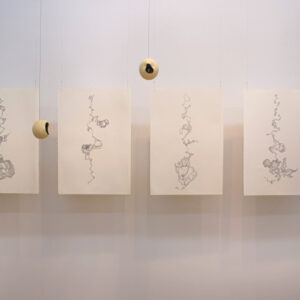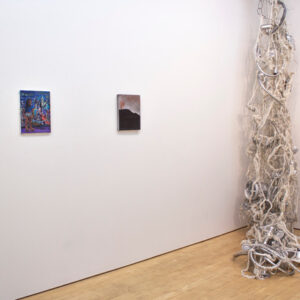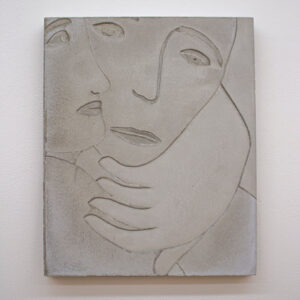A Fractured Sigh, an exhibition curated by two young curators and art historians, Charlotte Bravin Lee and Chiara Mannarino, opened on December 2nd at the BravinLee Programs gallery in Chelsea, Manhattan.
The idea came from wanting to create an exhibition that belonged to this historical moment or that could be related to it. While the concept of touch has been explored in many of the creative responses to this moment, breath remains largely neglected despite the critical role it has played in all of this year’s major events. For this reason, the two curators thought it would be a fruitful concept to explore in an exhibition, especially during the pandemic period.
Having chosen this theme, Charlotte and Chiara selected a group of diverse works that, directly or indirectly, engage with the notion of breath. A Fractured Sigh identifies this fundamental act, which has been impacted by the oppressive and stressful situation of the pandemic and the resulting lockdown. It is through the breath that contagion can develop and fear is able to manifest itself. In a general context, however, it takes on a different meaning. For example, relating to air pollution and disease, but also to its positive meaning of relief.

Thus, a breath experienced in a different way by each artist, based on various priorities, social themes, historical periods, personal experiences. For this reason, selecting artworks for the show was not easy. A Fractured Sigh is a group exhibition of painting, installation, photography, drawing, sculptural relief and video by ten contemporary artists: Tomoko Amaki Abe, Katie Armstrong, Todd Bienvenu, Katherine Bradford, Michael DeJong, Emily Fritze, Rhia Hurt, Carly Ries , Alessandro Teoldi, Woolpunk.
In reviewing the works of these artists, the exhibition examines positive and negative aspects relating to its theme: “Breath is the protagonist of this year’s main events: from Covid, which makes our every breath precious and simultaneously confined to the inside of a mask, to the Black Lives Matter movement and California wildfires that saturated the air with smoke,” explains curator Chiara Mannarino.

Although the works are distinguished by their varied techniques and concepts, the group show takes on a unique identity, in which the visual impact felt by the observer is closely linked to the curatorial decisions of the two curators. It is inevitable not to grasp how the setting, concept, and meaning of the chosen works, together with their arrangement, releases an energy and mood that is both fractured and unified.

Alessandro Teoldi, an Italian artist from Milan, with whom Chiara collaborated during Magazzino Italian Art’s “Homemade” project, which began during the lockdown, contributed two concrete “reliefs” to the exhibition. They are created by pouring cement over collaged paper that then disintegrates – a technique he developed during the lockdown. His Nocturne II stands out with its red sky polluted by grey smoke – evocative of the recent wildfires in California. What is impressive is the very deep sky, steeped in drama and poignant color of shades that do not bode well. The other work, Two, evokes the feeling of suffocation felt by many who were forced to coexist indoors during the lockdown: two disproportionate faces appear desperately pressed against each other; a hand from one figure squeezes the throat of the other portrayed.
A sculpture by Japanese artist Tomoko Amaki Abe is reminiscent of a polluted and charred lung. A detailed watercolor by Michael DeJong is like a small jewel. Depicting a tiny waterfall that lives on a large sheet of blank paper, his work is truly an intimate sigh of relief. It is also a remote idea of escape from reality, towards a reality that once was, or, perhaps, simply a detachment from the present.

As Charlotte and Chiara add, “Woolpunk’s installation (Michelle Vitale) clearly evokes water pollution and environmental degradation; but also Todd Bienvenu shows interest in the environmental theme with a painting that portrays a person looking longingly out at a polluted New York sky from within the confines of her own home; the figures portrayed in Katherine Bradford’s painting – identified as two night swimmers – is so abstract that it is difficult to know if the figures lie on the same plane or exist in different places and times. The setting may be underwater or more cosmic, but its visual forms and imagery evoke both freely flowing and stifled breath.
Katie Armstrong’s video is contemplative and enveloping, encouraging the viewer to breathe deeply and take time to reflect. In the audio, Armstrong describes everyday moments that unfold simultaneously – familiar to the lockdown period in which we were all having individual experiences within our own domestic spaces at the same time. The drawings and sound installation of a young artist named Emily Fritze are impressive: the drawings were created intuitively with eyes closed and leave the traces, and memory, of her emotional state during the pandemic.
Finally, a photograph printed on silk by Carly Ries evokes the materials of the masks that we now wear every day; while a collage by Rhia Hurt recalls the way in which different environments and ecosystems overlap and intersect through breath, and the ways in which this can be volatile and harmful during a time of pandemic. Its egg-like forms, however, point towards a hopeful rebirth to come.

This is a quick overview of the works in this exhibition, which deserve to be closely observed in person.
A Fractured Sigh is open until December 16 at BravinLee Programs, 526 West 26th Street, Suite 211, Chelsea, New York (Tuesday to Saturday, 11am to 6pm). To make an appointment send an e-mail to moc.eelnivarb@ofni












